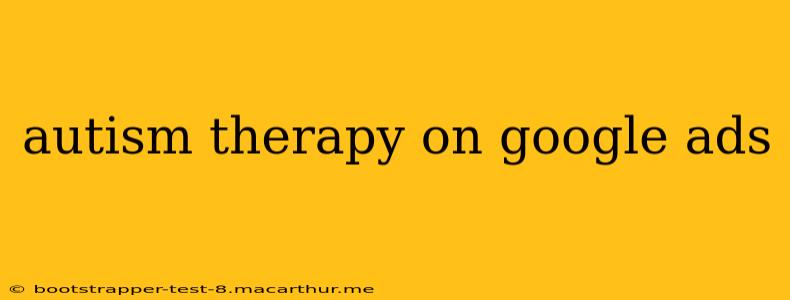Autism spectrum disorder (ASD) affects millions worldwide, making the need for effective therapies paramount. For clinicians, clinics, and organizations offering autism therapy, Google Ads presents a powerful tool to reach families seeking support. However, navigating the platform's policies and best practices requires careful consideration. This guide explores the intricacies of advertising autism therapy services on Google Ads, addressing common questions and offering strategic advice.
What are the Google Ads policies regarding autism therapy advertising?
Google Ads maintains strict guidelines to ensure responsible advertising in sensitive health-related sectors. Advertising autism therapy requires adherence to several key policies, including:
- Accurate and truthful representation: Ads must accurately depict the services offered, avoiding misleading claims or unsubstantiated promises of cures. Exaggerated claims regarding treatment efficacy are strictly prohibited.
- Compliance with healthcare advertising regulations: This includes adhering to any regional or national laws pertaining to healthcare advertising, especially those concerning the promotion of medical services. This often requires specific disclaimers and limitations on language used.
- Targeting restrictions: Google Ads imposes restrictions on targeting vulnerable groups, ensuring ads are not displayed in a way that exploits or unfairly targets individuals with ASD or their families.
- Transparency and disclosure: All ads must clearly identify the advertiser and the nature of the services provided. This includes disclosing any relevant licensing or qualifications. Avoid ambiguity.
- Prohibition of deceptive practices: This includes bait-and-switch tactics, hidden fees, and any other practices that deceive potential clients.
What types of autism therapy can be advertised on Google Ads?
A wide range of evidence-based autism therapies can be advertised, provided they adhere to Google's policies. These may include (but aren't limited to):
- Applied Behavior Analysis (ABA): A widely accepted and commonly advertised therapy.
- Speech and Language Therapy: Focusing on communication skills development.
- Occupational Therapy: Addressing sensory processing and daily living skills.
- Developmental Therapy: Encompassing a broader approach to skill development.
- Social Skills Training: Targeting improved social interaction abilities.
It's crucial to clearly specify the type of therapy offered in your ad copy. Vague or general terms should be avoided.
How can I create effective Google Ads for autism therapy?
Crafting effective ads requires a strategic approach:
- Keyword Research: Use tools like Google Keyword Planner to identify relevant keywords parents and caregivers use when searching for autism therapy. Consider long-tail keywords (e.g., "ABA therapy for nonverbal autism near me") for more targeted reach.
- Compelling Ad Copy: Use clear, concise, and empathetic language that resonates with families. Highlight the benefits of your services, emphasizing positive outcomes and focusing on your unique selling propositions.
- High-Quality Landing Pages: Direct users to a landing page specifically designed to convert leads. This page should provide detailed information about your services, your team's qualifications, and client testimonials.
- Targeted Campaigns: Utilize Google Ads' targeting options to reach specific demographics and geographic areas. Consider targeting parents, educators, and healthcare professionals.
- Ad Extensions: Utilize ad extensions to provide additional information, such as your location, phone number, and website link. This enhances visibility and click-through rates.
- Regular Monitoring and Optimization: Continuously monitor your campaign performance, adjusting your bids, keywords, and ad copy as needed to improve results. A/B testing can be invaluable.
What are the best practices for advertising autism therapy on Google Ads?
- Prioritize ethical considerations: Always uphold the highest ethical standards in your advertising.
- Focus on the client's needs: Frame your messaging around how your services can benefit families.
- Maintain transparency: Clearly state pricing and any limitations of your services.
- Be mindful of language: Avoid language that could be considered stigmatizing or discriminatory.
- Respect patient confidentiality: Ensure all advertising materials comply with privacy regulations.
What are some common mistakes to avoid when advertising autism therapy on Google Ads?
- Making unsubstantiated claims: Avoid exaggerating the effectiveness of your services or promising miraculous results.
- Targeting vulnerable populations inappropriately: Ensure your targeting is ethical and adheres to Google's policies.
- Using misleading or deceptive language: Be transparent and honest in your advertising.
- Ignoring campaign performance: Regularly monitor and optimize your campaigns to maximize ROI.
- Neglecting landing page optimization: A poorly designed landing page will negate your advertising efforts.
By carefully following Google's policies, adhering to best practices, and focusing on ethical and effective advertising, clinicians and organizations can leverage Google Ads to connect with families seeking autism therapy and make a positive impact. Remember, the ultimate goal is to provide helpful information and connect families with the appropriate care.
